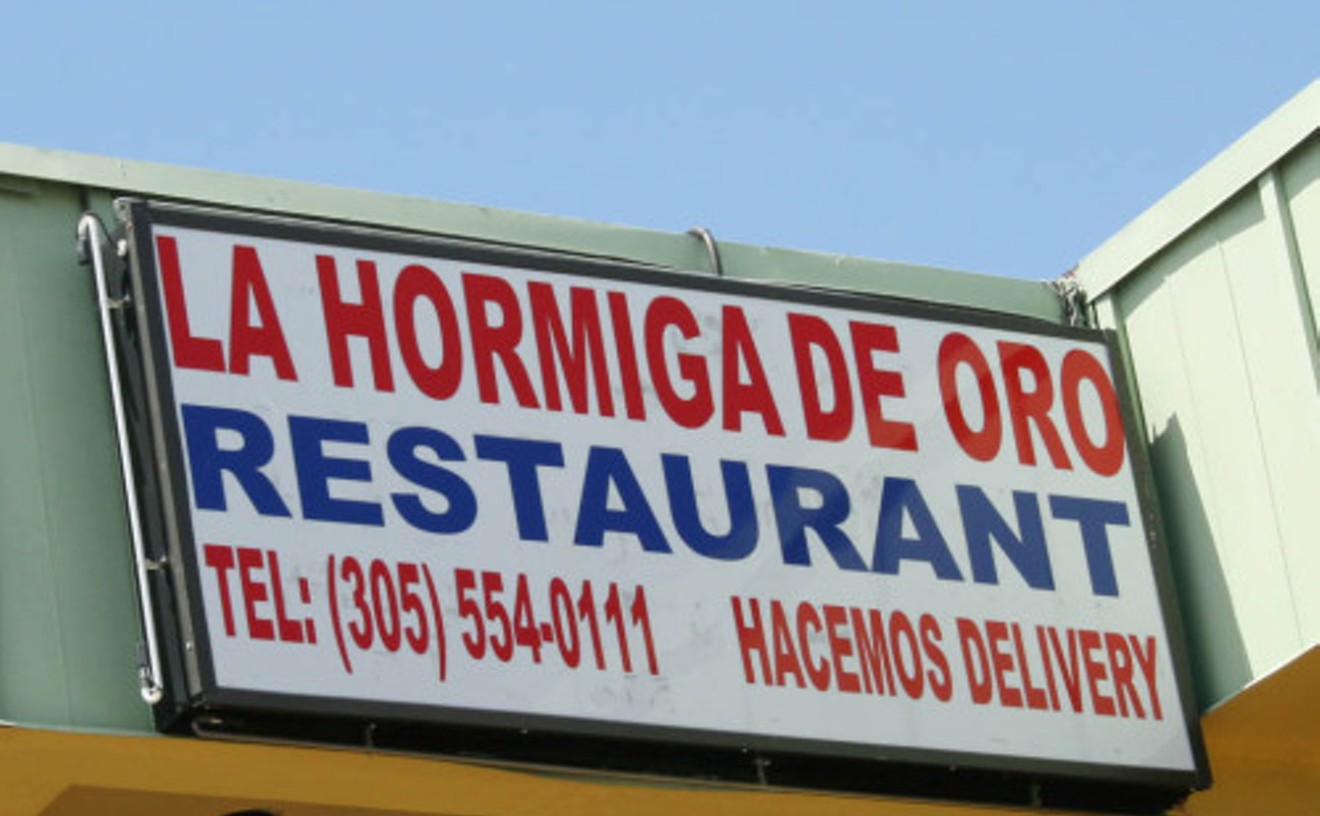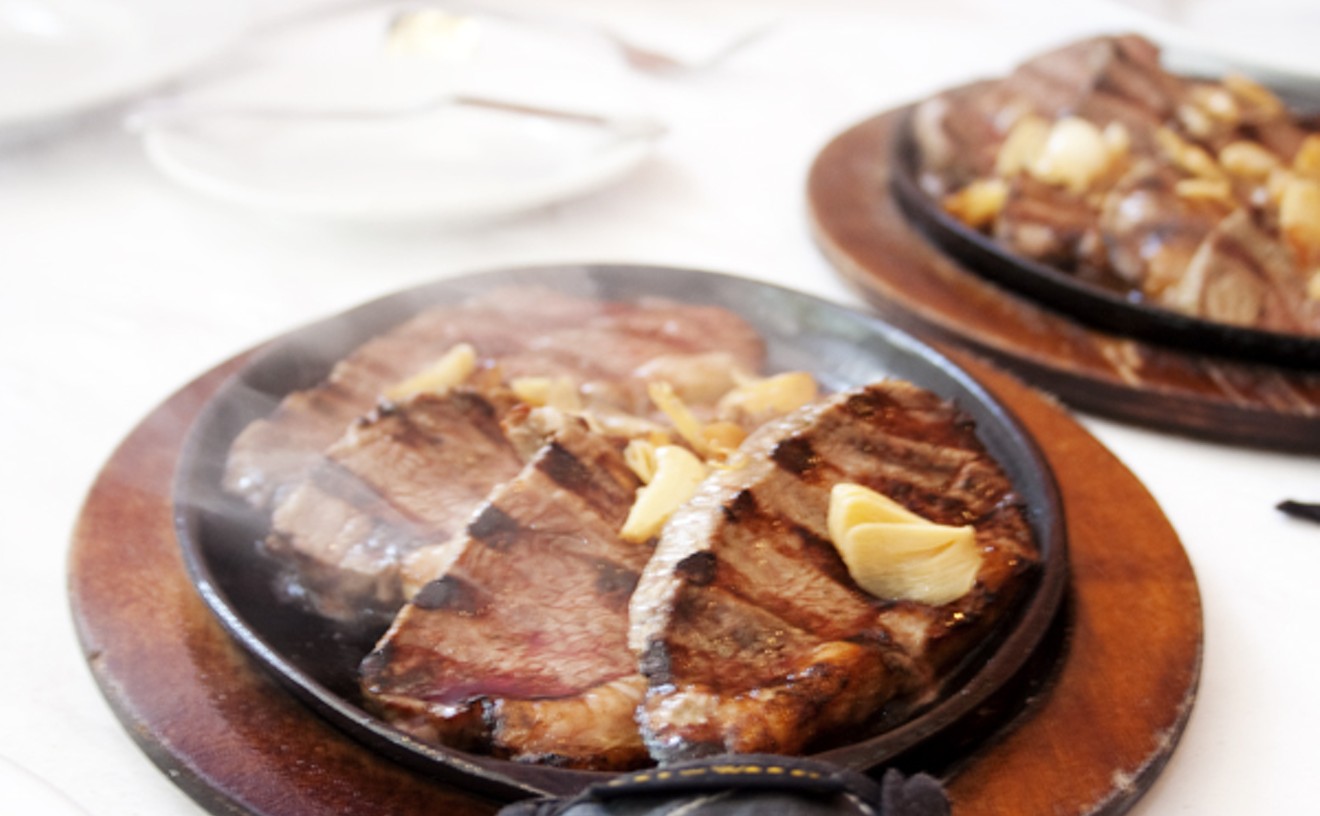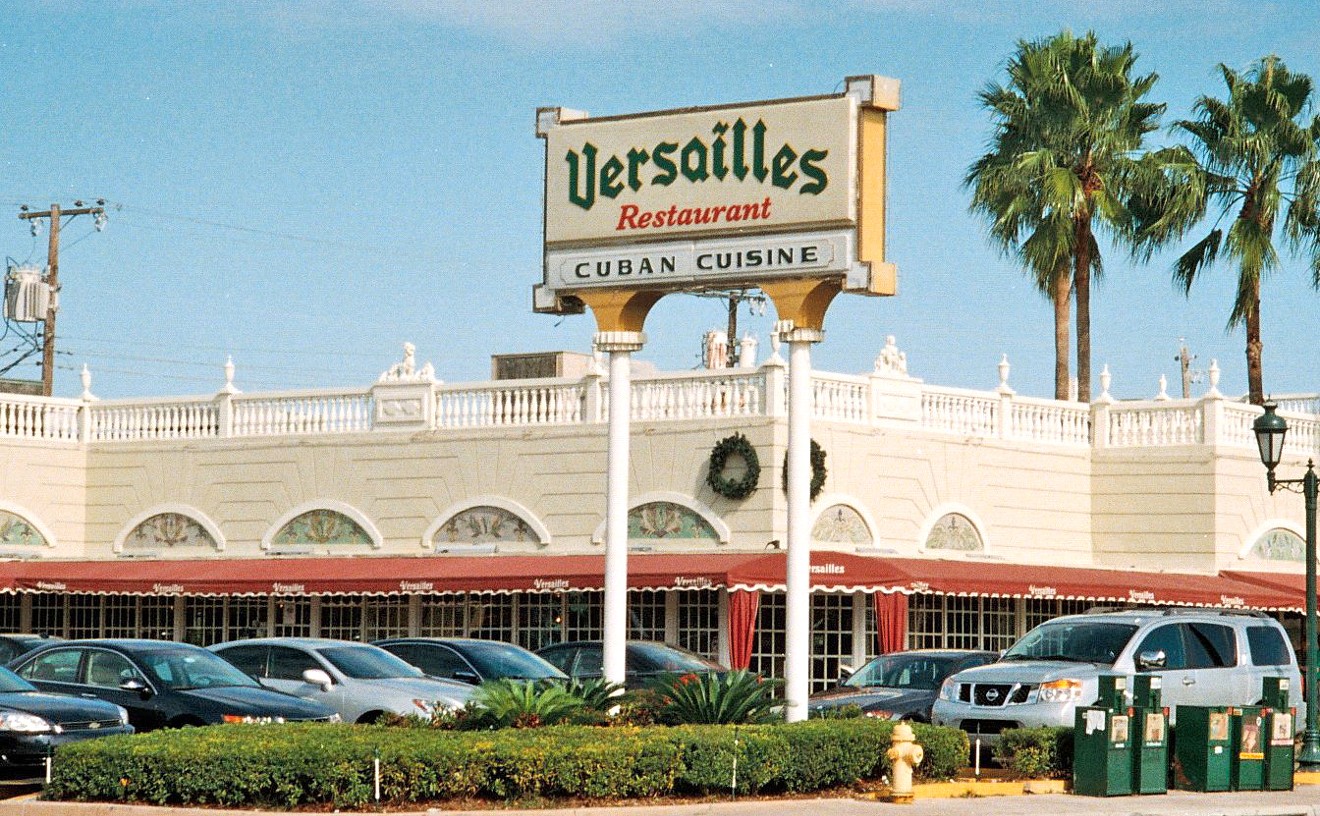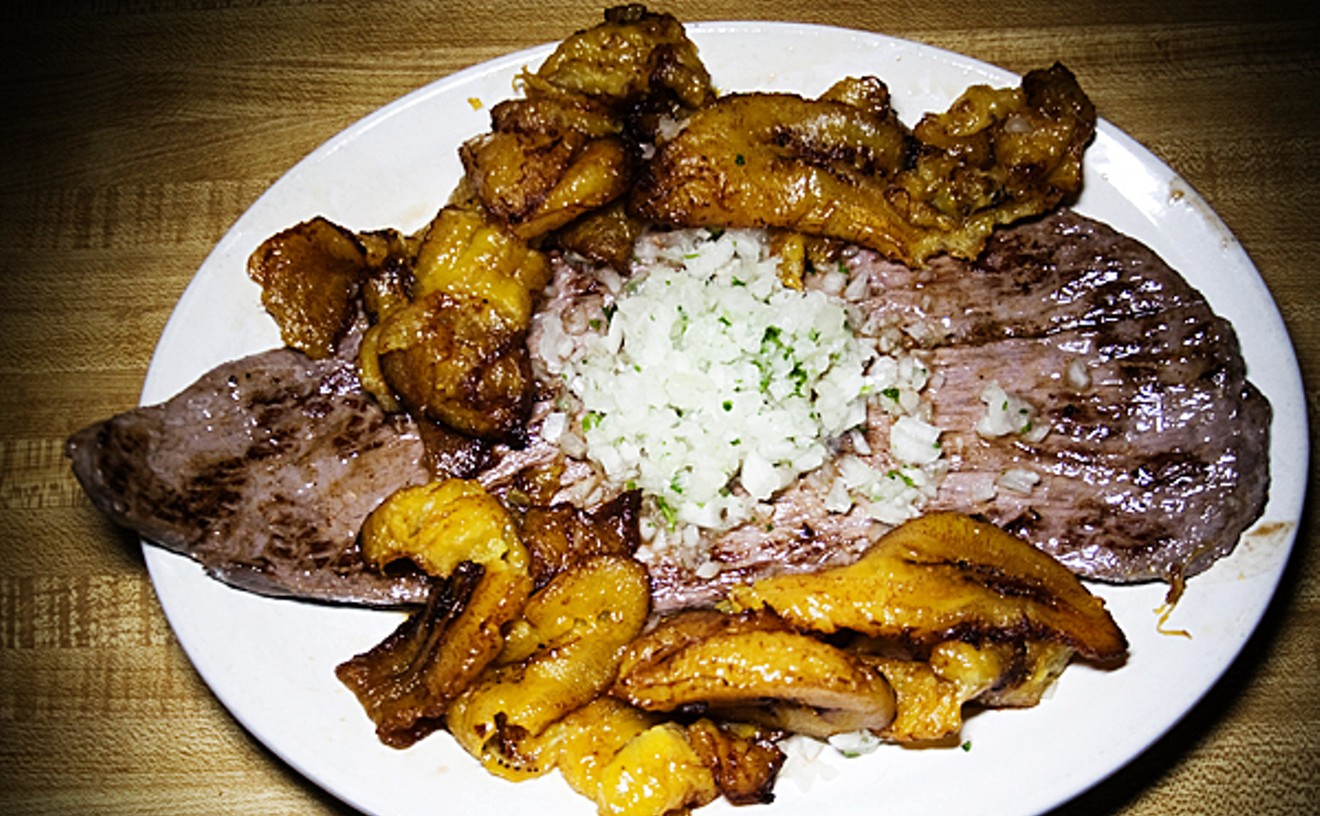Best Nicaraguan Restaurant
La Hormiga de Oro

Just off Miami Gardens Drive, inside a generic shopping center anchored by a Publix, you will find a golden opportunity to savor deliciously prepared Nicaraguan cuisine. A typical fritanga, La Hormiga de Oro offers cantina-style Nica dishes at moderate prices for dining in or taking out. Six dollars and 50 cents brings charbroiled steak and a choice of three sides that include gallo pinto (rice and beans), grilled corn on the cob, fried sweet plantains, tostones, fried yuca, fried cheese, and tortillas. Wash it down with a $3 glass of Nica fruit juice such as maracuya, cacao, or cebada. Folks looking for a twist on traditional breakfast fare can choose dishes such as huevos rancheros with white cheese, gallo pinto, and tortilla; or scrambled eggs with Spanish sausage, fried cheese, gallo pinto, and fried green plantains. Cost: $4.50 each. Family dinners are also available for $24 and $45. La Hormiga opens at 8 a.m. six days a week and 7 a.m. Saturdays, and closes at 10 p.m. daily.
- 18530 NW 67th Ave., Hialeah, 33015 Map
- 305-819-3018
Best Colombian Restaurant
Rincón Antioqueño

It's true that if you're not familiar with this place, you might miss it. It's also true that you are the last priority for the servers — you will wait for drinks, napkins, and food. Oh, and the parking sucks. But as soon as you set eyes on the flying-saucer-size pan de bonos, all of those details fade away. You'll be tempted to fill up on said pan de bonos or Rincón's perfectly crisp meat and potato empanadas, but resist at all costs. If you fall to temptation, your stomach will never have room to experience Rincón Antioqueño's Holy Grail — the bandeja paisa — a platter of steak or ground beef, fried bananas, fried pork belly, and a fried egg presented on a mound of white rice and served with an endless bowl of red beans. Your heart, your waistline, and your doctor might curse you — but your belly will thank you.
- 6521 SW 8th St., Miami, 33144 Map
- 305-262-1515
Best Place to Eat Colombian and Watch Hockey
Casa Vieja Restaurant & Bar

It can be difficult deciding what to do if you find yourself on Hammocks Boulevard in West Kendall. What, you didn't know there was anything to do out there? It's home to Kendall Ice Arena, the funniest place to watch people bust their asses while wearing down-feather parkas in the middle of July. It's also home to a giant restaurant designed to look like an old house, where patrons perform vallenatos at weekly karaoke, and politicians such as Joe Garcia attempt to woo West Dade's Colombian community. But even better, you don't have to choose between watching hilarious ice sports and singing your heart out on a huge stage beneath a replica colonial window balcony. Casa Vieja's back wall is made of glass and overlooks the skating rink. So cozy up in a booth, order a platter of churrasco asado ($16.99) with some tostones and rice, and try to distract hockey players by dangling juicy meat behind the goal post. We told you the Hammocks are fun.
- 10325 Hammocks Blvd., Kendall, 33196 Map
- 305-386-6638
Best Brazilian Restaurant
Little Brazil

Alexandra Rincon
Brazil, in almost every conceivable way, is the opposite of little. The largest country in South America has an exploding economy and an oversize world presence set to get bigger with the World Cup and the Olympics heading there in the next few years. The excellent Brasileño cuisine at Miami's Little Brazil restaurant isn't exactly minuscule either. The kitchen pumps out heaping plates of authentic specialties, including picanha, thinly sliced steak topped with slivers of roasted garlic and farofa, a vinegary salad; camarao com Catupiry, jumbo baked shrimp stuffed with Catupiry, a creamy cheese beloved in the land of samba; even a crazy steak Cavalo, a thick strip topped with fried eggs. On the weekends, stop by to try Brazil's national dish done right: Little Brazil's feijoada — a stew of black beans, beef, bacon, pork, and ribs — is rich, decadent, and unctuous. The only thing little about the place is its cozy space, whose walls hold rows of plates painted with scenes from around Brazil. It's the perfect spot for a big night of Brazilian.
- 6984 Collins Ave., Miami Beach, 33141 Map
- 305-397-8215
- littlebrazilrestaurant.com
Best Argentine Restaurant
Patagonia

Argentines are known for their arrogance and red meat. At Patagonia, you get plenty of the latter without much of the former. Miami has a glut of Argentine meat factories/steak houses, and most are pricey. But this place in Coral Gables seems to dispense with presentation in favor of substance. Sure, there's no waiter service — you order at the counter — and there's little similarity between this eatery and other Gables fine-dining restaurants, but we view that as a positive. Patagonia has street cred to go along with its sidewalk seating and an enviable mastery of the famous gaucho parrilla (Argentine barbecue). A wide variety of meat cuts are available for dine-in or take-home, including entraña (skirt), vacio (flank), and bife de chorizo (sirloin). And don't forget the chorizo (sausage). Additionally, the shop boasts an extensive wine selection and a long pastry counter featuring masas finas, facturas, and other baked goods. Looking for a quick bite before you take in a show at the nearby Actors' Playhouse? Then order an empanada and sandwich de miga.
- 244 Miracle Mile, Coral Gables, 33134 Map
- 305-640-8376
- www.patagoniausa.net/gables/index.html
Best Organic Latin American Cuisine
Bernie's L.A. Café
Benevolent dictator. Cheap Lamborghini. Hilarious Pauly Shore film. Some adjectives simply don't belong next to some nouns. The combination jars the eyes and sets the brain aflame: Something is wrong here! In Miami, the proximity of organic to Latin American cuisine has exactly that effect on far too many diners inured for years to greasy arepas and questionably sourced ropa vieja. Those diners have never been to Bernie's L.A. Café, a tiny, hiply appointed eatery with 30 seats and a countertop in an Alton Road storefront. Chef Bernie Matz — known for his stint at the Café at Books & Books — marries Miami's sultry mix of Latin American cuisines with the freshest organic ingredients. And guess what? It's delicious. From a traditional picadillo made with 100 percent hormone-free sirloin to similarly sourced fricase de pollo (half a tender chicken in spicy tomato-creole sauce) to a mouthwatering fish pan-fried in a simple coconut sauce, Bernie's never sacrifices taste for organic cachet. Say it with us: organic Latin American cuisine. At Bernie's, that's no oxymoron.
Best Cuban Restaurant
Islas Canarias

Photo by Phillip Pessar via Flickr Creative Commons
Sure, you can get a sandwich de medianoche and a giant plate of vaca frita anywhere in this town. But what if you're craving harder-to-find Cuban specialties such as tasajo con boniato, cured, salted beef boiled soft with vegetables and spices and served with sweet potato; or pechuga con quimbobo, chicken slowly stewed with potatoes and okra? At those times, you'll want to head to Islas Canarias, a spot curiously named for a region of Spain. It has been a Miami Cuban food institution for more than 30 years. The ambiance is Scarface-chintzy: neon lights, strip mall surroundings, and old-timers and huge familias packed into tight seating. But the locally famous croquetas ($1.15 each) — wrapped in a thin layer of batter, cleanly fried, and stuffed with creamy, cumin-seasoned pork — are alone worth the venture.
- 3555 SW Eighth St., Miami, 33135 Map
- 305-444-0240
- www.versaillesrestaurant.com
Best Batido
Los Pinareños Frutería

When the nostalgia thermometer of a Cuban exile registers a dangerously high level, it usually signifies the person is in a state of hallucinatory shock known as "acaba de llegar." Symptoms include calling all friends socios, having a packed bag that weighs exactly 44 pounds sitting next to the door, and frequently waving a ration book at the man behind the counter at Los Pinareños Frutería. This last behavior is understandable — after all, the open-air fruit stand housing mangos, mameys, guanabanas, nisperos, and coconuts neatly arranged in cardboard boxes held up by long sticks of sugarcane can be easily confused for any Pinar del Río timbiriche. The occasional wandering roosters also don't help. The smartest thing to do if you spot someone in this state of mind is let them be. Order a sapodilla shake, which you won't find anywhere else. Light up a self-rolled cigar. And watch the 90-mile divide wither away.
- 1334 SW 8th St., Miami, 33135 Map
- 305-285-1135
Best Flan
Rio Cristal

Natalia Molina
Like sugar melted into caramel, flan in Miami constantly burns a hole through our hearts. It's so easy to make: eggs, milk, and sugar — maybe a little vanilla or cinnamon — whisked into a custard. And every Latin American country has its own perfected rendition. So why are we constantly subjected to overly creamy masses of what basically amounts to pudding violently infused with corn syrup at even the fanciest restaurants? We expect our flan to jiggle, the loving result of a traditional bain-marie cooking method. And we want it imbued with real sugar, but not such massive amounts that we must schedule several root canals in anticipation. Enter Rio Cristal, an unfancy, greasy-plate Cuban joint whose flan ($3.90) wiggles like a stripper at a Lil Wayne party, sits in a pool of syrup so shimmery it blinds us, and melds into creamy goodness as it restores our faith in "Spanish cheesecake."
- 9872 Bird Rd., Miami, 33165 Map
- 305-223-2357
- www.riocristalrestaurant.com
Best Croissant
Le Royal French Bakery

When in search of French boulangeries where you can twirl your mustache, ponder life's intricacies over a cup of café au lait, and enjoy romantic accordion music in your head, you probably head for Miami Beach. But the French twins who own Le Royal, a tiny café tucked into a strip mall, know better. They had the foresight to predict hungry University of Miami scholars would need butter to function; antsy Sunset Place shoppers would delight in more than six types of croissants; and stressed-out commuters stuck in traffic on South Dixie Highway would require pit stops to refuel on flaky carbs. So the brothers rolled out the pastry dough, kneaded in copious amounts of beurre, and delicately folded glorious petite crescents to create the only pastries in South Miami that sell out by midafternoon. Choose from plain, apple, or almond. Stuff with ham and cheese, guava and cheese, or simply enjoy as light-as-a-feather, billowy bread without garnish. Either way, you'll merci beaucoup us during your next trip to mall hell.
- 7370 Red Rd., South Miami, 33143 Map
- 305-665-6631





